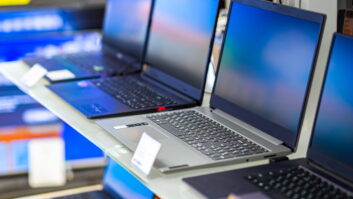Reston, Va. — Sales of pricier phones with QWERTY keyboards, touchscreens and smartphone operating systems all gained share in the third quarter, boosting the share of phones priced at more than $100, according to research company ComScore M:metrics.
For the three months ending September, an average 22.6 percent of handsets sold each month featured hard QWERTY keyboards, up from a monthly average of 9.5 percent during the year-ago period. The average per-month share of touchscreen devices rose to 10 percent from 3.6 percent, and the average monthly share of phones priced at more than $100 rose to 28.5 percent from 22.1 percent.
The company also found that:
– RIM and Apple led in smartphone sales, with RIM gaining share over the year-ago period even as Apple rose to the No. 2 unit-share spot;
-LG, RIM, Samsung,and Apple gained share as Motorola, Kyocera, Nokia and Sanyo lost share; and
-carriers maintained their commanding share of 64 percent of handset sales to consumers over the year-ago period.
For the survey, ComScore conducts monthly online surveys of 10,000 consumers ages 13 and older, with a new sample surveyed every month. Self-reported responses are verified against a proprietary database of devices, operator services and the like. Respondents are asked whether they bought their phone or it was given to them as a gift or by their employer.
Among the key findings:
-average monthly sales during the three-month period rose 8.8 percent to an average 3.39 million per month;
-the share of smartphones doubled during the surveyed period to a monthly 14.9 percent from the year-ago 7.5 percent; and
-RIM maintained its No. 1 share of smartphone sales, and Apple came close to unseating the Windows Mobile OS for second-place honors.
During the three months ending in September, RIM boosted its share of total phone sales to 5.7 percent from 2.4 percent. Windows Mobile-based smartphones accounted for 3.8 percent of average monthly cellphone sales, and Apple accounted for 3.6 percent of sales, up from the year-ago average of 1.3 percent.
Smartphone brand share: In terms of brand share within the smartphone market, ComScore found that RIM was tops with 37.7 percent, followed by Apple’s 24 percent and Palm’s 11.1 percent. Despite stiff competition from Apple’s iPhone 3G, RIM boosted its share to 37.7 percent from the year-ago 32 percent, likely due in part to a drop in Palm’s share to 11.1 percent from 18.7 percent. Apple’s year-ago share wasn’t large enough to be tallied separately.
Form factors: Phone share by form factor also changed. ComScore found that:
-the share of slider phones rose to a monthly average of 12.8 percent from the year-ago 5.2 percent, presumably because of the growth of QWERTY-keyboard models that often use the slider form factor;
–the share of clamshells fell dramatically to 51.5 percent from 71.7 percent; and
-the share of bar phones picked up to 5.7 percent from 2.4 percent.
Price changes: The pricing mix also changed, ComScore found. Fewer phones were obtained free as part of a subscriber’s contract, with an average 22.7 percent of phones acquired in each of the three months ending September being free, down from the year-ago average of 29.4 percent. Phones priced up to $99 accounted for an average of 42 percent of sales, down slightly from the year-ago 42.6 percent. And phones priced at $100 and up accounted for an average of 28.5 percent of monthly sales, up from the year-ago 22.1 percent.
Cellphone brand share: LG’s share rose to 22.4 percent from 18 percent; RIM’s share rose to 5.7 percent from 2.4 percent; and Samsung’s share rose to 19.9 percent from 17.7 percent. Motorola’s share slipped to 24.6 percent from 34.2 percent, and Nokia’s share slipped to 10.4 percent from 12.1 percent, and
Distribution share: The carriers still have it wrapped up, accounting for an average 63.8 percent of the phones sold each month for the three-month period, almost the same as the year-ago 63.9 percent. Less than 1 percent of the respondents got their phone from their employer during that time. In the indirect channel, the largest retailer was Wal-Mart, which accounted for an average 4.6 percent of the phones acquired by consumers each month, followed by eBay’s 3.3 percent, Best Buy’s 2.4 percent, RadioShack’s 2 percent, Let’sTalk.com’s 1.2 percent, and Amazon and Circuit City, each with 0.9 percent. Independent wireless retailers accounted for 6.7 percent of sales.













